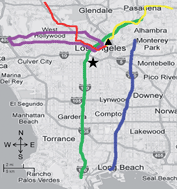According to the U.S. Census Bureau, 570 000+ commuters in Los Angeles travel for over 60 minutes to work. Studies have shown that a substantial portion of particulate matter (PM) exposure can occur during this commute. This study represents the integration of the results from five commute environments in Los Angeles. Personal PM exposures are discussed for the: (1) METRO gold line, a ground-level light-rail route, (2) METRO red line, a subway line, (3) the 110, a high volume freeway with low heavy-duty vehicle (HDV) fraction, (4) the 710, a major corridor for HDVs from the Port of Los Angeles, and (5) Wilshire/Sunset Boulevards, major surface streets. Chemical analysis including total and water-soluble metals and trace elements, elemental and organic carbon (EC/OC), and polycyclic aromatic hydrocarbons (PAHs) was performed. The focus of this study is to compare the composition and estimated lung cancer risk of PM2.5 (dp < 2.5 μm) for the five differential commute environments. Metals associated with stainless steel, notably Fe, Cr, and Mn, were elevated for the red line (subway), most likely from abrasion processes between the rail and brakes; elements associated with tire and brake wear and oil additives (Ca, Ti, Sn, Sb, and Pb) were elevated on roadways. Elemental concentrations on the gold line (light-rail) were the lowest. For water-solubility, metals observed on the red line (subway) were the least soluble. PAHs are primarily derived from vehicular emissions. Overall, the 710 exhibited high levels of PAHs (3.0 ng m−3), most likely due to its high volume of HDVs, while the red and gold lines exhibited low PAH concentrations (0.6 and 0.8 ng m−3 for red and gold lines, respectively). Lastly, lung cancer risk due to inhalation of PAHs was calculated based on a commuter lifetime (45 years for 2 hours per workday). Results showed that lung cancer risk for the 710 is 3.8 and 4.5 times higher than the light-rail (gold line) and subway (red line), respectively. With low levels of both metal and PAH pollutants, our results indicate that commuting on the light-rail (gold line) may have potential health benefits when compared to driving on freeways and busy roadways.


 Please wait while we load your content...
Please wait while we load your content...